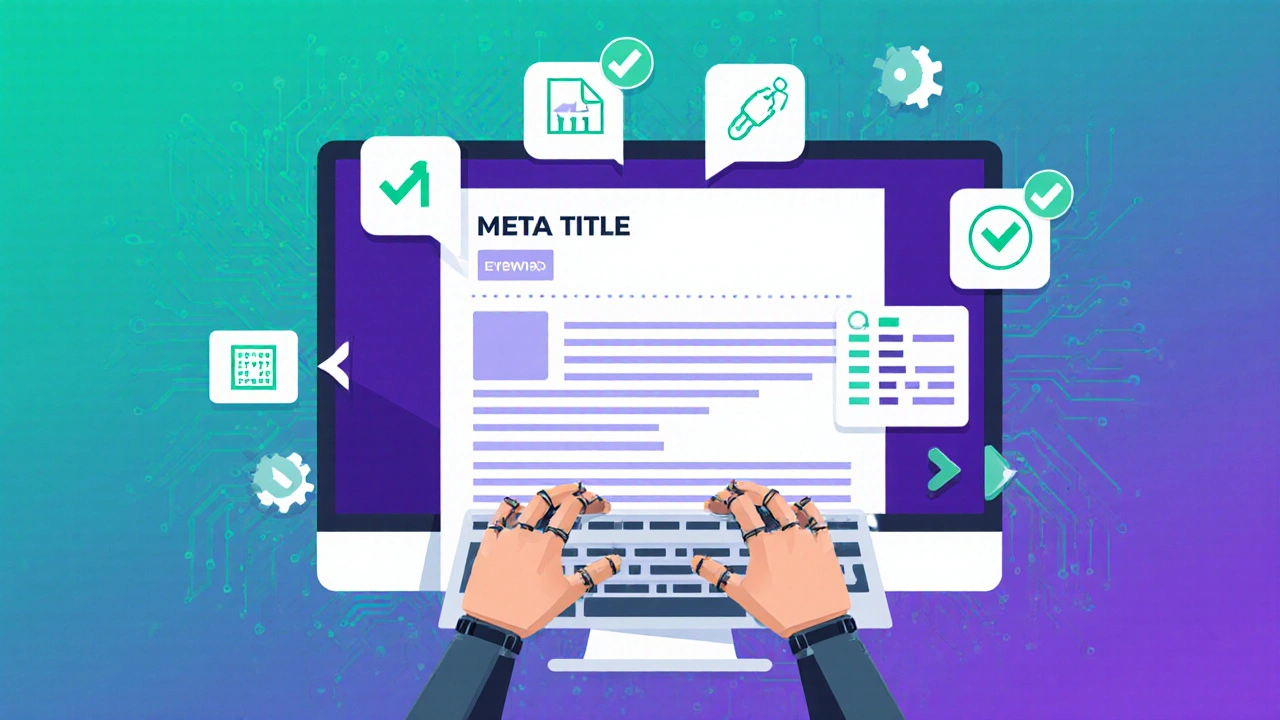SEO Prompt Builder
Build Your SEO Prompt
Want to level up your search rankings without spending endless hours on manual research? ChatGPT SEO can turn a tedious process into a fast, data‑driven workflow. This guide shows exactly how to harness the power of OpenAI’s language model for keyword research, content creation, on‑page tweaks, and even backlink outreach - all while keeping the results human‑friendly and Google‑approved.
Key Takeaways
- Craft precise prompts to extract high‑value keywords and search intent.
- Use ChatGPT to draft SEO‑optimized copy that passes AI‑detector checks.
- Automate meta‑tag and snippet generation with structured prompts.
- Integrate AI‑generated outreach emails for faster backlink acquisition.
- Set up a simple rank‑tracking loop to refine prompts over time.
Understanding the Players
When it comes to modern search optimization, ChatGPT is an AI language model developed by OpenAI that can generate human‑like text based on prompts and has quickly become a go‑to tool for marketers. SEO search engine optimization, the practice of improving a website’s visibility in organic search results relies on three core pillars: keyword research, high‑quality content, and authoritative backlinks. By marrying ChatGPT’s language abilities with SEO fundamentals, you get a hybrid workflow that’s both scalable and adaptable.
Setting Up Effective Prompts
Prompt engineering is the secret sauce. The clearer your instruction, the better the output. Think of the prompt as a brief you’d give a human copywriter: specify the target keyword, desired word count, tone, and any SEO constraints (like keyword density or LSI terms). Here’s a template you can copy‑paste:
"Write a 800‑word blog post about [primary keyword] targeting {search intent}. Include an H1, three H2 headings, a meta title under 60 characters, and a meta description under 160 characters. Use a conversational tone and sprinkle in LSI keywords: [list]."
Experiment with temperature settings (0.7 for creativity, 0.2 for precision) if you’re using the API. Save your most successful prompts in a shared document - they become reusable assets for your whole team.

Using ChatGPT for Keyword Research
Keyword Research the process of discovering search terms that people enter into search engines, along with metrics like volume and difficulty is where AI shines. Ask ChatGPT to generate a list of related terms, questions, and long‑tail variations for a seed keyword. Example prompt:
"Give me 20 long‑tail keywords related to ‘organic skincare routine’, include monthly search volume (US), keyword difficulty (0‑100), and the primary user intent."
The model will return a table you can copy into Excel. Cross‑check the numbers with a dedicated tool (Ahrefs, SEMrush) to confirm accuracy - AI provides ideas fast, but verification keeps you grounded.
Generating SEO‑Friendly Content
Once you have a keyword list, let ChatGPT draft the first version of your article. Use the prompt template from the previous section and add a few extra constraints:
- Specify the target readability score (e.g., Flesch‑Kincaid 60‑70).
- Ask for a “call‑to‑action” paragraph at the end.
- Request inclusion of at least three internal links to existing content.
After the draft arrives, run it through a plagiarism checker and an AI‑content detector. If the detector flags a high probability of AI‑generated text, tweak the prompt to increase temperature or ask for a “human‑style rewrite.” This two‑step loop ensures the copy feels natural while still benefiting from AI speed.
Optimizing On‑Page Elements
Meta titles, descriptions, and schema snippets are critical for click‑through rates. Prompt ChatGPT to produce multiple options, then pick the best one based on character limits and keyword placement. For example:
"Create three meta titles (max 60 characters) and three meta descriptions (max 160 characters) for an article about ‘vegan protein powders’ targeting commercial intent. Include the primary keyword ‘vegan protein powder’ in each title."
Don’t forget SERP Snippet Optimization the practice of crafting title tags and meta descriptions to improve visibility and click‑through rates on search engine results pages. Test different snippets using Google Search Console’s URL Inspection tool to see which version yields higher CTR.

Leveraging ChatGPT for Backlink Outreach
Backlinks remain a ranking powerhouse, and outreach can be time‑consuming. Use ChatGPT to draft personalized outreach emails that reference the recipient’s content and propose a specific link opportunity.
"Write a 150‑word outreach email to the author of ‘10 Best Plant‑Based Snacks’, suggesting they link to our new guide on ‘High‑Protein Vegan Breakfast Ideas’. Mention one point from their article and keep the tone friendly and professional."
Pair the AI‑generated email with a spreadsheet that tracks response rates, domain authority, and follow‑up dates. Over time, you’ll notice which phrasing yields higher reply rates and can adjust prompts accordingly.
Tracking Rankings and Tweaking Prompts
After publishing AI‑assisted content, set up a simple rank‑tracking loop. Tools like Google Search Console, Ahrefs Rank Tracker, or a free SERP API can pull daily position data for your target keywords. Record the performance in a dashboard and compare against baseline metrics (pre‑AI content). If rankings dip, revisit the prompts: perhaps the keyword density needs adjustment or the meta description could be more compelling.
Quick Checklist
- Define clear prompts for each SEO task (research, drafting, meta tags, outreach).
- Validate AI‑generated keyword stats with a trusted tool.
- Run drafts through plagiarism and AI‑detector checks.
- Craft multiple meta title/description options and test CTR.
- Log outreach emails and monitor reply rates.
- Set up rank‑tracking and schedule prompt revisions every 4‑6 weeks.
Frequently Asked Questions
Can I use the free ChatGPT web interface for SEO tasks?
Yes, the free version works for basic keyword lists and short copy drafts. For bulk tasks, the API offers higher limits, faster response times, and the ability to control temperature and token count.
Will Google penalize AI‑generated content?
Google’s guidelines focus on content quality, not the tool used. If the AI output is original, helpful, and passes human review, it’s safe. Always run a human edit and make sure the article satisfies user intent.
How often should I update my prompts?
Treat prompts as living documents. Review them after each major algorithm update or when you notice a drop in CTR or rankings. A quarterly audit usually catches most issues.
Can ChatGPT help with technical SEO audits?
It can generate checklists and explain concepts, but for crawling and reporting you still need tools like Screaming Frog or Sitebulb. Use ChatGPT to interpret the raw data into actionable recommendations.
Is there a risk of duplicate content across multiple AI‑generated pages?
If you feed identical prompts without variation, the model may output similar paragraphs. Mitigate this by customizing prompts per topic and adding unique data points or case studies.




Write a comment